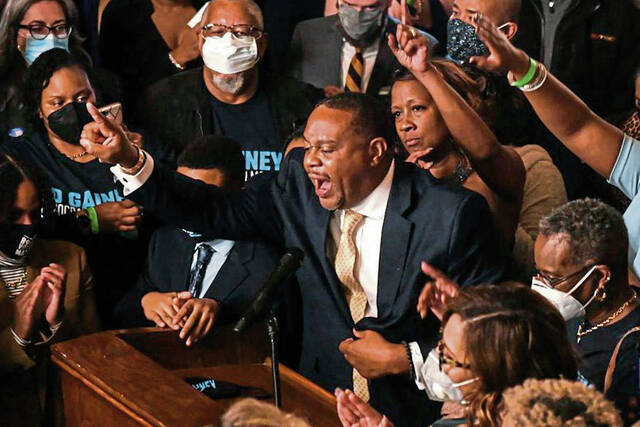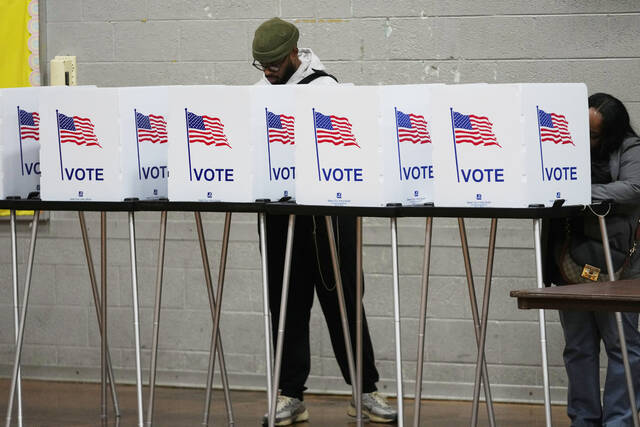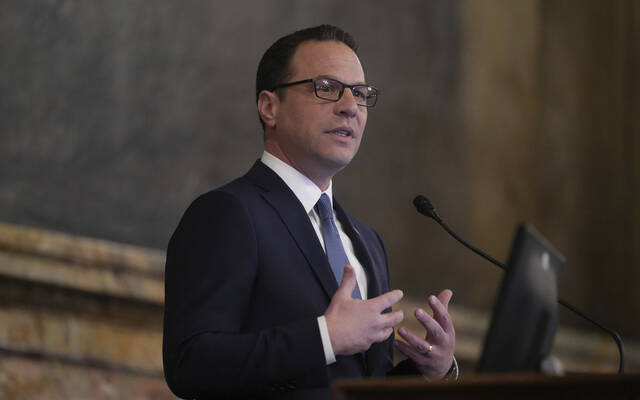Allegheny County cast more votes in the November election than any other Pennsylvania county — surpassing even Philadelphia, which has about 350,000 more residents and 100,000 more registered voters.
Allegheny County Executive Rich Fitzgerald said the county’s robust efforts to help people vote by mail were a key factor.
Fitzgerald said the county has provided vote-by-mail instruction videos, sent out mail-in ballot applications with free return postage and expanded use of the County Office Building for de facto early voting using vote-by-mail.
“I’m really proud of these efforts and how successful they’ve been in increasing turnout,” Fitzgerald said. “While Philadelphia has a larger number of voters than us, we outvoted the county in the last election by 70,000 votes. It’s clearly been impactful.”
Democrats have embraced no-excuse, mail-in voting more readily than Republicans since it was first allowed in 2020. Some Republicans have been critical of it — former President Donald Trump alleged, without evidence, that mail-in voting was “rigged” — and that has likely contributed to the GOP’s lower percentage of voting by mail.
But local GOP leaders are now trying to get their voters to embrace mail-in voting, saying it is necessary to keep up with Democrats and win elections.
Turnout rising
In the few years before no-excuse, mail-in voting was instituted in 2020, turnout was noticeably less compared to elections in the few years since.
In the 2017 general election, voter turnout in Allegheny County was about 23.6%, records show. In the 2021 general election, which like 2017 was a municipal election, voter turnout was 33.3%.
There also was a noticeable jump between the 2018 midterms and the 2022 midterms, Allegheny County records show.
Westmoreland County saw similar boosts in turnout. In the 2017 general election, voter turnout in Westmoreland County was about 27%, but it increased to 36% in 2021.
Between the 2018 and 2022 midterms, voter turnout in Westmoreland jumped from 59.5% to 68.1%.
The percentage of people voting by mail in each of the two major parties is down from highs in 2020 when the pandemic was still raging at full tilt and voting by mail was seen by many as a safer alternative than going to the polls.
But the percentage of Democrats voting by mail has fallen more slowly than it has for Republicans, and the percentage of Democrats voting by mail is still more than three times higher than it is for Republicans.
Allegheny County Democrats also have increased their margins of victories at the top of the ticket since 2020.
In 2020, President Joe Biden received one of the highest margins of Allegheny County’s vote in presidential history. In 2022, Democrats flipped two state House seats within the county as turnout increased by a few percentage points compared to 2018.
Democrats take the lead
Sam Hens-Greco, chairman of the Allegheny County Democratic Committee, said mail-in voting has made it easier for Democrats to boost their overall turnout and reach new voters who don’t normally vote every year.
Hens-Greco said mail-in voting has allowed Allegheny County Democrats to stretch their resources since they can now tell a few weeks ahead of elections which of their voters have already cast ballots.
Party organizers typically focus on “super voters,” or voters who participate in every election. Hens-Greco said the Democratic Committee is still focusing on those voters, but in 2022, the committee also sent out 25,000 mailers to low propensity voters, or those who vote more sporadically. He said about 30% of those low propensity voters signed up to be engaged in 2022 elections.
“We thought that was pretty good,” he said.
Hens-Greco doesn’t want to assign all turnout gains to mail-in voting. He noted that issues such as abortion and opposition to Republican candidates also were strong motivating factors for Democratic voters in 2022. He also said he thinks the quality of his party’s candidates has improved, and local progressive and liberal activist groups such as UNITE and Order of the Phoenix have implemented their own voter turnout campaigns.
But he does believe that mail-in voting has helped boost turnout.
“When you are given more options, the more engagement you will have,” he said.
Hens-Greco added that voting by mail was especially helpful in Democrats’ three recent special election victories. Because many mail-in voters were on the permanent status list from the 2022 election, he said thousands of voters in those special election districts automatically received a ballot at their home address.
One of the three Democratic candidates in the Feb. 7 special elections races saw more votes from mail-in ballots than ones cast in person. The two others saw mail-in tallies just below 50% of the Democratic votes cast.
In all three special elections in districts where Democrats already held a significant voter registration edge, Democrats won by a margin of at least 48 percentage points.
Allegheny County Republican Chairman Sam DeMarco said winning those special elections would have been a “near impossible task” for Republicans, but he acknowledged that mail-in voting provided a boost to Democrats.
Records appear to support that claim. The 35th State House District had special elections in 2018 (before the mail-in voting law changed) and on Feb. 7. Turnout in the Mon Valley district was about 10.7% in March 2018, but it more than doubled to 21.4% earlier this month.
Hens-Greco believes Democrats can boost numbers even more.
“There is absolutely more room to grow,” he said.
New embrace
DeMarco said that since midterm election losses last year, he has been trying to get local Republican voters and organizers to embrace mail-in voting. Past Republican stigmatization of mail-in voting has made that difficult, he said.
“The Republicans need to use this,” DeMarco said. “Unfortunately, former President Trump is railing against the use of mail-in voting, and it has slowed the acceptance of it for Republicans.”
He acknowledged the structural advantages of campaigns knowing that some of their voters have already cast ballots before Election Day. He said Democrats have reaped those benefits and Republicans need to catch up.
DeMarco said he doesn’t prefer no excuse, mail-in voting, but he accepts it as state law.
“If I were king, there wouldn’t be mail-in ballots. But I am not,” he said. “These are the rules that we have, and I may not like them, but I like losing even less. Republicans need to adapt if they want to win.”
He said many Republicans are reluctant to vote by mail because of how long it can take for mail-in ballots to be tabulated. But that isn’t an issue anymore in Allegheny County.
DeMarco praised Fitzgerald for having the Allegheny County Elections Division count mail-in ballots so quickly (typically well before in-person votes are counted) and said he hopes that will encourage more local Republicans to trust mail-in voting.
DeMarco said he understands that most counties are not as efficient as Allegheny County in counting mail-in votes, which could be keeping Republicans there from embracing the voting method.
Republican mail-in voting rates are lower in Westmoreland County compared to Allegheny County. In the 2022 general election, about 9% of the Republican ballots in Westmoreland County were returned by mail, while that figure was nearly 12% in Allegheny County.
Both Westmoreland and Allegheny Democrats voted by mail at the same rate in 2022, about 37% of their ballots.
There have been small gains for Westmoreland County Republican voters.
In the 2021 general election, their mail-in voting rate was 8.5% and in the 2022 general election that rate increased to 9%.
Republican registration figures also are growing in Westmoreland, and that is showing up in elections.
Republican candidates in Westmoreland have increased their margins of victory by several points over the years. In 2018, Republican Senate candidate Lou Barletta won Westmoreland County by 9 points, while 2022 Republican Senate candidate Mehmet Oz won by 19 points.
DeMarco doesn’t attribute all turnout growth to mail-in voting. He said a 24-hour political news cycle has also increased voter interest.
While DeMarco said mail-in voting has provided Democrats a boost, he also lamented the poor quality of some Republican candidates since 2018.
Since DeMarco’s efforts, local turnout boosts from mail-in votes for Republicans have been mixed.
In last year’s general election in the 35th State House District, about 9% of Republicans voted by mail. In the Feb. 7 special election, that percentage increased to 18% of Republican votes.
However, it appears Republican mail-in vote gains are being outpaced by Democratic gains.
Republicans lost the special election race by a larger margin than last year’s general election race. While the GOP share of mail-in votes increased, Democrats increased their share even more — going from about 30% of Democrats voting by mail in last year’s general election to 49% on Feb. 7.
DeMarco said he’s hopeful about Republican county executive candidate Joe Rockey’s campaign. He said Rockey’s message of political moderation can be a winner for Republicans.
“The lesson is there are red counties, blue counties and purple counties,” he said. “If we want Allegheny County to be purple, we need to nominate people who can win here, instead of nominating people who will only win in York County.”








